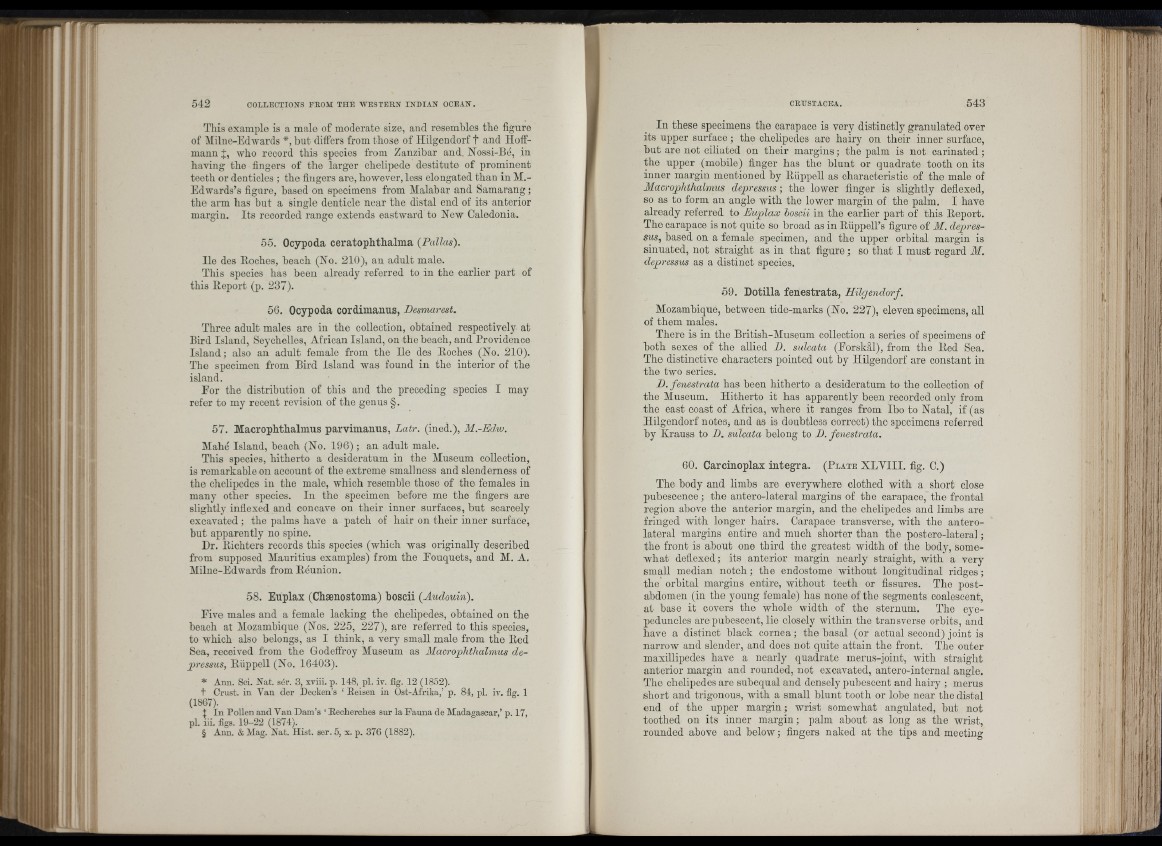
This example is a male of moderate size, and resembles tbe figure
of Miliie-EdAvards *, but differs from those of Hilgendorf t and Hoffm
an n ], who record this species from Zanzibar and . Nossi-Be, in
having tbe fingers of the larger chelipede destitute of prominent
teeth or denticles ; tbe fingers are, boAvever, less elongated than in M.-
Edwards’s figure, based on specimens from Alalabar and Samarang ;
the arm lias but a single denticle near the distal end of its anterior
margin. Its recorded range extends eastward to New Caledonia.
55. Ocypoda ceratophthalma {Pallas).
He des Eocbes, beach (No. 210), an adult male.
Tbis species has been already referred to in tbe earlier part of
tbis Eeport (p. 237).
56. Ocypoda cordimanus, Desmarest.
Three adult males are in tbe collection, obtained respectively at
Bird Island, Seychelles, African Island, on the beach, and Providence
Island; also an adult female from the He des Eoches (No. 210).
The specimen from Bird island was found in tbe interior of tbe
island.
For the distribution of this and the preceding species I may
refer to my recent revision of tbe genus §.
57. Macrophthalmus parvimanus, Latr. (ined.), M.-Edw.
Alahé Island, beach (No. 196) ; an adult male.
This species, hitherto a desideratum in the Aluseum collection,
is remarkable on account of the extreme smallness and slenderness of
tbe chelipedes in tbe male, which resemble those of the females in
many other species. In the specimen before me tbe fingers are
slightly inflexed and eoncaim on tbeir inner surfaces, but scarcely
excavated ; tbe palms have a patch of hair on tbeir inner surface,
but apparently no spine.
Dr. Eichters records tbis species (which was originally described
from supposed Mauritius examples) from tbe Eouquets, and M. A.
Milne-Edwards from Eeunion.
58. Euplax (Cbænostoma) boscii {Audouin).
Eive males and a female lacking tbe chelipedes, obtained on the
beach at Alozamhique (Nos. 225, 227), are referred to tbis species,
to which also belongs, as I think, a very small male from the Eed
Sea, received from tbe Godeffroy Aluseum as Macrophthalmus de-
Eiippell (No. 16403).
* Ann. Sci. Nat. sér. 3, xviii. p. 148, pi. iv. flg. 12 (1852).
t Crust, in Van der Deeken’s ‘ Eeisen in Ost-Afrika,’ p. 84, pi. iv. fig. 1
(1867).
j In Pollen and Van Dam’s ‘ Eecherches sur la Fauna de Madagascar,’ p. 17,
pi. iii. figs. 19-22 (1874).
§ Ann. & Mag. Nat. Hist. ser. 5, x. p. 376 (1882).
In these specimens tbe carapace is very distinctly granulated over
its upper surface; the chelipedes are hairy on tbeir inner surface,
but are not ciliated on tbeir margins; the palm is not carinated ;
the upper (mobile) finger has the blunt or quadrate tooth on its
inner margin mentioned by Elippell as characteristic of tbe male of
Alacrophthalmus depressus ; tbe lower finger is slightly defiexed,
so as to form an angle with the lower margin of tbe palm. I have
already referred to Euplax hoscii in tbe earlier part of this Eeport.
Tbe carapace is not quite so broad as in Eiippell’s figure of AI. depressus,
based on a female specimen, and tbe upper orbital margin is
sinuated, not straight as in th a t figure; so th at I must regard M.
depressus as a distinct species.
r i f i
59. Dotilla fenestrata, Hilgendorf.
Mozambique, between tide-marks (No. 227), eleven specimens, all
of them males.
There is in tbe Britisb-Museum collection a series of specimens of
botb sexes of the allied D. sulcata (Eorskal), from the Eed Sea.
The distinctive characters pointed out by Hilgendorf are constant in
tbe two series.
D. fenestrata has been hitherto a desideratum to the coUection of
the Museum. Hitherto it has apparently been recorded only from
the east coast of Africa, where it ranges from Ibo to Natal, if (as
Hilgendorf notes, and as is doubtless correct) tbe specimens referred
by Krauss to D. sulcata belong to D. fenestrata.
n I
60. Carcmoplax integra. (P late X LV III. fig. C.)
Tbe body and limbs are everywhere clothed witb a short close
pubescence ; the antero-lateral margins of the carapace,”tbe frontal
region above tbe anterior margin, and the chelipedes and limbs are
fringed with longer hairs. Carapace transverse, with tbe anterolateral
margins entire and mucb shorter than the postero-lateral ;
the front is about one third the greatest width of the body, somewhat
defiexed; its anterior margin nearly straight, witb a very
small median notch ; the endostome Avithout longitudinal ridges ;
the orbital margins entire, without teeth or fissures. Tbo postabdomen
(in the young female) has none of tho segments coalescent,
at base it covers the whole width of the sternum. Tbe eye-
peduncles arc pubescent, lie closely within the transverse orbits, and
have a distinct black cornea; the basal (or actual second) joint is
narrow and slender, and does not quite attain the front. Tbe outer
maxillipedes have a nearly quadrate merus-joint, witb straight
anterior margin and rounded, not excavated, antero-internal angle.
Tbo cbelipcdes are subequal and densely pubescent and hairy ; merus
short and trigonous, witb a small blunt tooth or lobe near tbe distal
end of tbe upper margin; wrist somewhat angulated, but not
toothed on its inner margin ; palm about as long as the wrist,
rounded above aud below; fingers naked at the tips and meeting
r i , J 'l